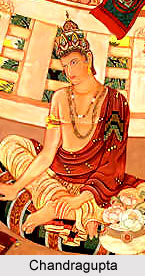 India witnessed Peace and prosperity under the Gupta Empire. This period was marked by extensive achievements in science, dialectic, literature, logic, mathematics, astronomy, technology, engineering, art, religion and philosophy. It came into being as a result of the destruction of the Kushana Empire.
India witnessed Peace and prosperity under the Gupta Empire. This period was marked by extensive achievements in science, dialectic, literature, logic, mathematics, astronomy, technology, engineering, art, religion and philosophy. It came into being as a result of the destruction of the Kushana Empire.
Origin of the Gupta Empire
The origin of the Gupta dynasty still remains unclear. Though the records of the Sunga Dynasty and Satavahana dynasty mention many officials bearing the surname Gupta, their relationship with the imperial Guptas cannot be determined. Also, though there is specific proof of a primitive Gupta clan, there is no means of connecting the same to the rulers of the Gupta Empire. The history of the Gupta dynasty began with its founding by Sri-Gupta around 240 CE. The empire enclosed most of Northern India and Eastern Pakistan, parts of Gujarat and Rajasthan and what is now western India and Bangladesh.
Rulers of the Gupta Empire
The first three rulers of the Gupta dynasty are Maharaja Sri Gupta, his son Maharaja Sri Ghatotkacha and his son Chandragupta. It was under the last ruler that the Gupta Empire went on to become firmly consolidated and went on to enhance the power of the dynasty. Following his coronation as king of Magadha in A.D. 319-320, Chandra Gupta took the title of `Maha Rajadhiraja`, Great King of Kings. He was followed by his son Samudragupta, in the year 335 AD. He planned to bring about the unification of India and make himself the head and thereby adopted the principle of Digvijaya.
The main power point of the Gupta Kingdom was the Ganga heartland. This secured a friendly southern frontier for the Guptas, which was necessary to Samudra Gupta`s successor, Chandragupta II, when he led a movement against the Sakas in western India. It was during the reign of Chandragupta II that Gupta pre-eminence was at its peak.
Chandragupta II was succeeded by his son Kumara Gupta, who went on to set up a peaceful rule of forty years. The last years of his reign however saw the commencement of a long period of troubles due to the incursion of the Pushyamitra tribe. His son Skanda Gupta ascended the throne after fighting a bitter battle of succession with his brothers. The last known King of the Guptas was Vishnu Gupta, following whom the Gupta dynasty fell into dismay and eventually collapsed.
Administration of the Gupta Empire
Gupta administration bears a resemblance to that of the Mauryas in superficial terms. Though ultimate power in the kingdom still lay with the king, the focus was more on local administration and lesser control from the centre. There was well-organised administration and political unity in India under the Guptas. The vast empire was divided into provinces, which were under the control of the governors who were from the royal family. The standing army was laced with cavalry and horse archery. The Gupta judicial system was developed with a differentiation between civil and criminal laws.
Economy of the Gupta Empire
The economy of the Gupta Empire had a systematised operating mechanism. Revenue from land came at a steady rate, and this was further added to by income from commercial activity. India had established trading relations with the islands of South-East Asia, Malaysia, Cambodia, and Thailand. The textile guilds had a huge domestic and foreign market. Spices, indigo, sandalwood, pearls, pepper, perfume, precious stones, herbs, and textiles were exported in large quantities. Inland trade was promoted by the political constancy that had been established here by the Guptas. The towns of Banaras, Sarnath, Nasik, Paithan, Pataliputra, Mathura, Ujjain, Kanchi and Tamralipti were famous trading centers.
Art and Architecture of the Gupta Empire
In terms of art, architecture and painting, and the other arts, the Gupta period is one of the most innovative periods of Indian history. The rock cut caves belonging to the Buddhist; Jain and Brahmanical sects are interesting aspects of Gupta architecture. The Ajanta caves, Sarnath Buddha, the panels of Dashavatara Temple in Deogarh and the Udayagiri Varaha Cave are remarkable accomplishments of the age. The Gupta era also heralded a new era in the history of temple architecture. Free standing structural temples were built in this period. Permanent materials like stone and brick were used in the construction of these temples for the first time. Grammar, astronomy, metaphysics, logic, mathematics, and medicine became greatly specialised during the reigning period of the Gupta kings. Sanskrit literature reached at its highest glory during this period which produced works like Mricchakatika by Sudraka, Panchatantra, along with Kalidasa, Bhasa and others. In mathematics, Aryabhatta brought the concept of `zero` or infinity.
Decline of the Gupta Empire
Following the reign of Vishnu Gupta, the Gupta Empire finally came to an end. The process of disintegration had started before the advent of Vishnu Gupta to the throne. In fact the reign of Skanda Gupta can be said to have marked the commencement of the decline of the Gupta Empire. The unexpected invasion of north western India by the Huns posed a serious challenge to the authority of the Guptas. Disagreement within the imperial family was another major reason that shook the stability of the Gupta Empire. The constant wars of succession weakened the hold of the central authority over the feudatories. Frail administrative systems also led to a downfall of the Gupta Empire.
Gupta Empire went on to introduce a new epoch in the history of India. The decline of the Gupta Empire saw the shifting of power to the South, as the north was now broken up into a number of warring kingdoms.